Overview
The article emphasizes the critical role of cumulative voting in enhancing decision-making within unions. By allowing members to express their preferences more fully, cumulative voting not only promotes inclusivity but also ensures that diverse perspectives are represented in organizational decisions. This representation fosters a more engaged and democratic membership, which is vital for the health and effectiveness of unions.
Furthermore, the adoption of cumulative voting can lead to more informed and representative outcomes, ultimately strengthening the union’s position and influence. Union leadership must consider this approach as a means to empower their members and enhance overall participation.
Introduction
Cumulative voting has emerged as a transformative approach within labor unions, providing a platform for diverse voices to be heard and represented. This method not only empowers members to allocate their votes strategically but also enhances overall engagement in decision-making processes.
As unions evolve, however, questions arise regarding the effectiveness of traditional voting methods and the pressing need for innovative solutions. How can cumulative voting adapt to modern challenges and further enrich union governance? This inquiry is crucial for union leadership seeking to navigate the complexities of contemporary labor dynamics.
Votem CastIron: Secure Online Voting for Unions
Votem’s CastIron platform stands as a secure and compliant online ballot solution tailored for labor organizations. By adhering to stringent regulations, including NCUA and DOL requirements, the platform guarantees that every vote is encrypted and auditable, fostering a high level of voter trust. This advanced technology simplifies the voting process, ensuring accessibility for everyone, regardless of their location.
Furthermore, by utilizing CastIron, organizations can conduct transparent and efficient elections, significantly increasing participant engagement and turnout. Research indicates that e-voting can notably boost participation among previously abstaining voters, showcasing its effectiveness in mobilizing members.
With features such as real-time results and customizable ballots, CastIron not only meets compliance standards but also enhances the overall electoral experience for organizations in 2025 and beyond.

Historical Use of Cumulative Voting in Labor Unions
An important cumulative voting example illustrates the significant history within labor organizations, serving as a vital mechanism to ensure minority perspectives are acknowledged in decision-making processes. This approach serves as a cumulative voting example, empowering participants to allocate multiple votes to candidates or issues they are passionate about, thereby enhancing representation. Historically, labor organizations have utilized a cumulative voting example as a countermeasure against the dominance of majority groups, ensuring that all members possess a fair opportunity to influence outcomes. This practice has been instrumental in fostering a more inclusive environment within organizations.
Furthermore, the cumulative voting example profoundly impacts decision-making within labor organizations by allowing diverse viewpoints to shape the outcomes of elections and initiatives. By enabling members to express their preferences with greater flexibility, organizations can more accurately reflect the interests of their entire membership base. As the landscape of electoral practices evolves, it is imperative for labor leadership to address the implications of outdated resources, such as the FairVote website, which no longer provides current information on cumulative balloting.
To further bolster the implementation of cumulative elections, labor leaders should delve into case studies that serve as a cumulative voting example to demonstrate its effectiveness in enhancing inclusivity and representation. Adopting cumulative balloting can empower participants and cultivate a collaborative atmosphere, ultimately leading to fairer decision-making processes.
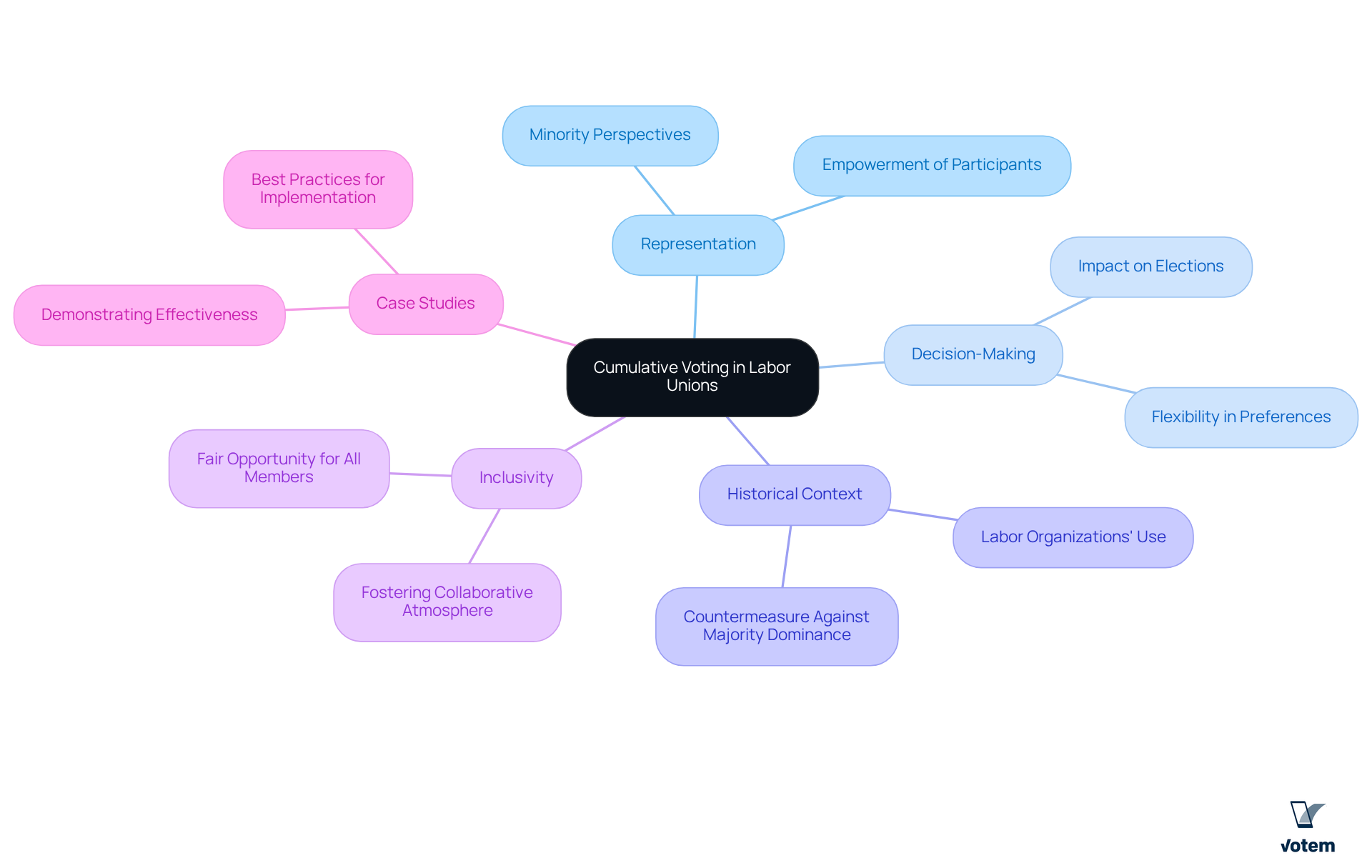
Dot Voting: Visual Preference Expression in Union Decisions
Dot selection is a straightforward yet powerful technique that empowers union participants to visually express their preferences by applying colored dots to various options. This engaging method not only streamlines the selection process but also facilitates rapid aggregation of preferences, making it simpler to pinpoint areas of consensus and identify topics that warrant further discussion.
By fostering open dialogue on crucial issues, dot selection promotes heightened involvement among participants, ultimately leading to more informed and democratic decision-making. The visual nature of this approach significantly enhances participant engagement, cultivating a sense of ownership and active participation in the organization’s decision-making processes.
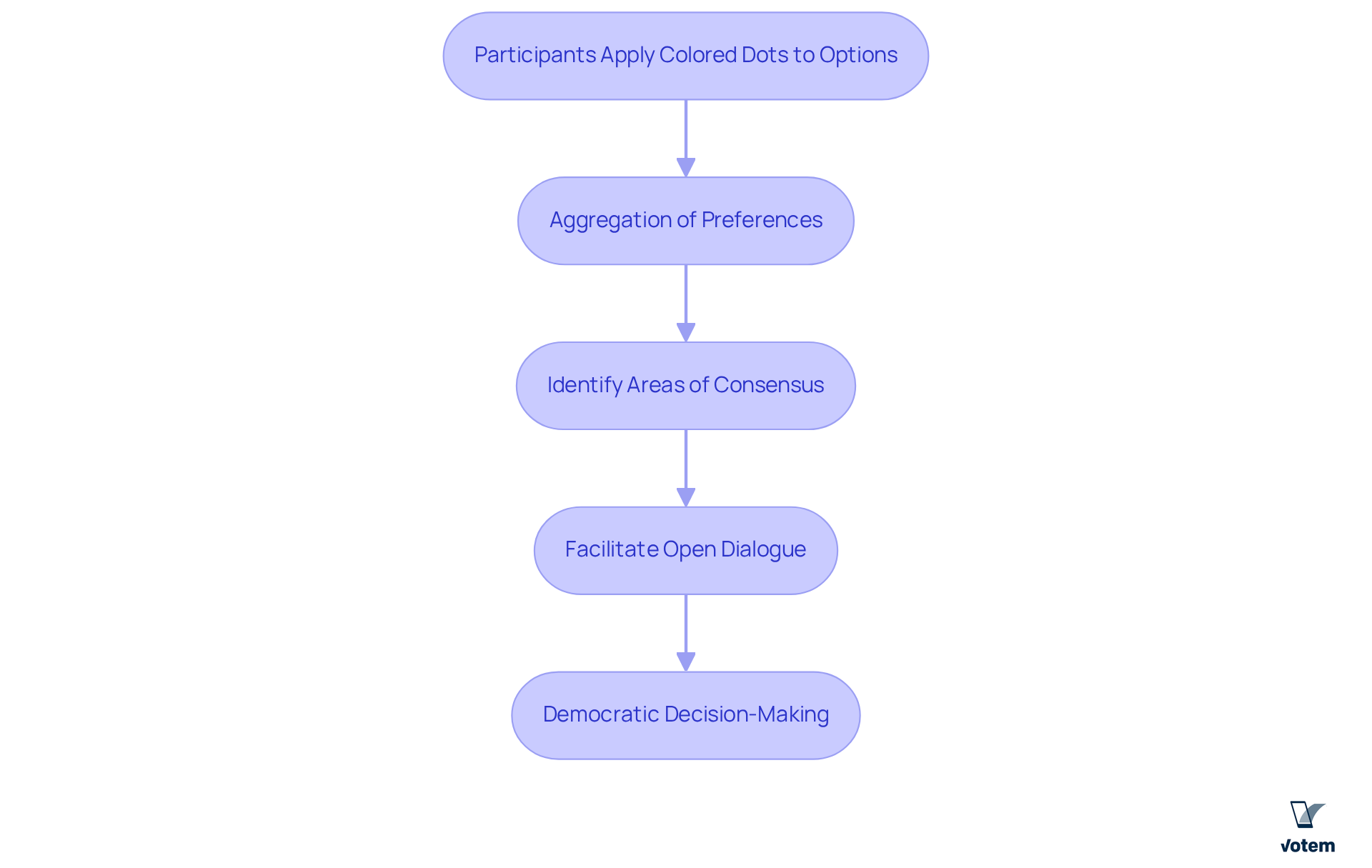
Fractional Voting: Tailoring Votes to Member Preferences
Fractional voting empowers individuals to allocate their votes across various options or matters according to their preferences. This method proves particularly advantageous in associations, where members often have differing levels of support for various candidates. By enabling participants to distribute portions of their votes, unions can achieve a more nuanced representation of sentiment, leading to decisions that more accurately reflect the collective will. This approach not only fosters inclusivity but also significantly enhances member engagement in the electoral process.
Votem’s innovative online ballot solutions have played a crucial role in boosting participation rates. The New Mexico State Republican Party’s satisfaction with Votem’s software, which they intend to utilize again for their upcoming elections, exemplifies this success. Furthermore, Votem effectively managed 299,000 ballots for the National Radio Hall of Fame, showcasing the efficiency of modern electoral systems in improving accessibility for all voters, including those with disabilities.
As one labor leader noted, partial balloting facilitates a more democratic process, ensuring that every member’s viewpoint is valued, regardless of their chosen candidate’s popularity. To fully leverage the benefits of proportional ballots, associations should consider utilizing Votem’s services. This strategy not only boosts voter engagement but also ensures that each ballot contributes to shaping the organization’s future.
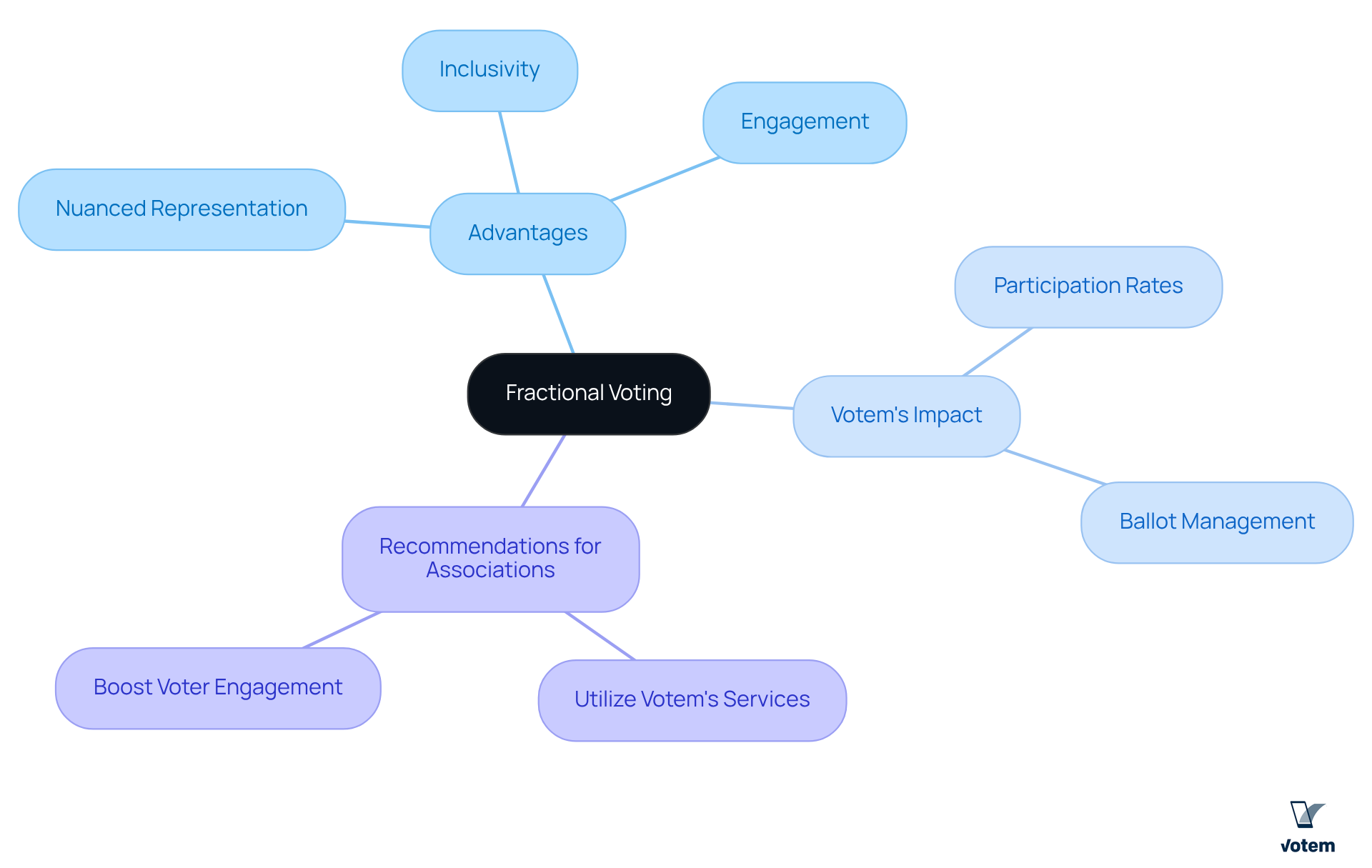
Plumping: Maximizing Influence in Union Elections
Plumping is a strategic voting method where voters concentrate their support on a single candidate rather than dispersing their votes among multiple contenders. This approach significantly enhances an individual’s chances of success in electoral contests, where a robust and focused base of support is crucial. Union participants must identify optimal moments to employ plumping, particularly when a nominee embodies their shared interests and values.
For instance, in recent labor elections, those who effectively utilized plumping strategies experienced notable increases in their success rates, demonstrating the power of this approach. Union leaders have emphasized the importance of this strategy, asserting that it empowers individuals to amplify their voices and ensure that their preferred candidates are positioned for victory. However, voters should carefully consider the potential implications of plumping on overall representation, as concentrating votes on one individual may unintentionally diminish the diversity of perspectives within leadership.
By strategically implementing plumping, union members can maximize their influence and bolster the likelihood of electing candidates who authentically represent their interests. This calls for a thoughtful approach to voting that balances individual preferences with the broader need for diverse representation in leadership roles.
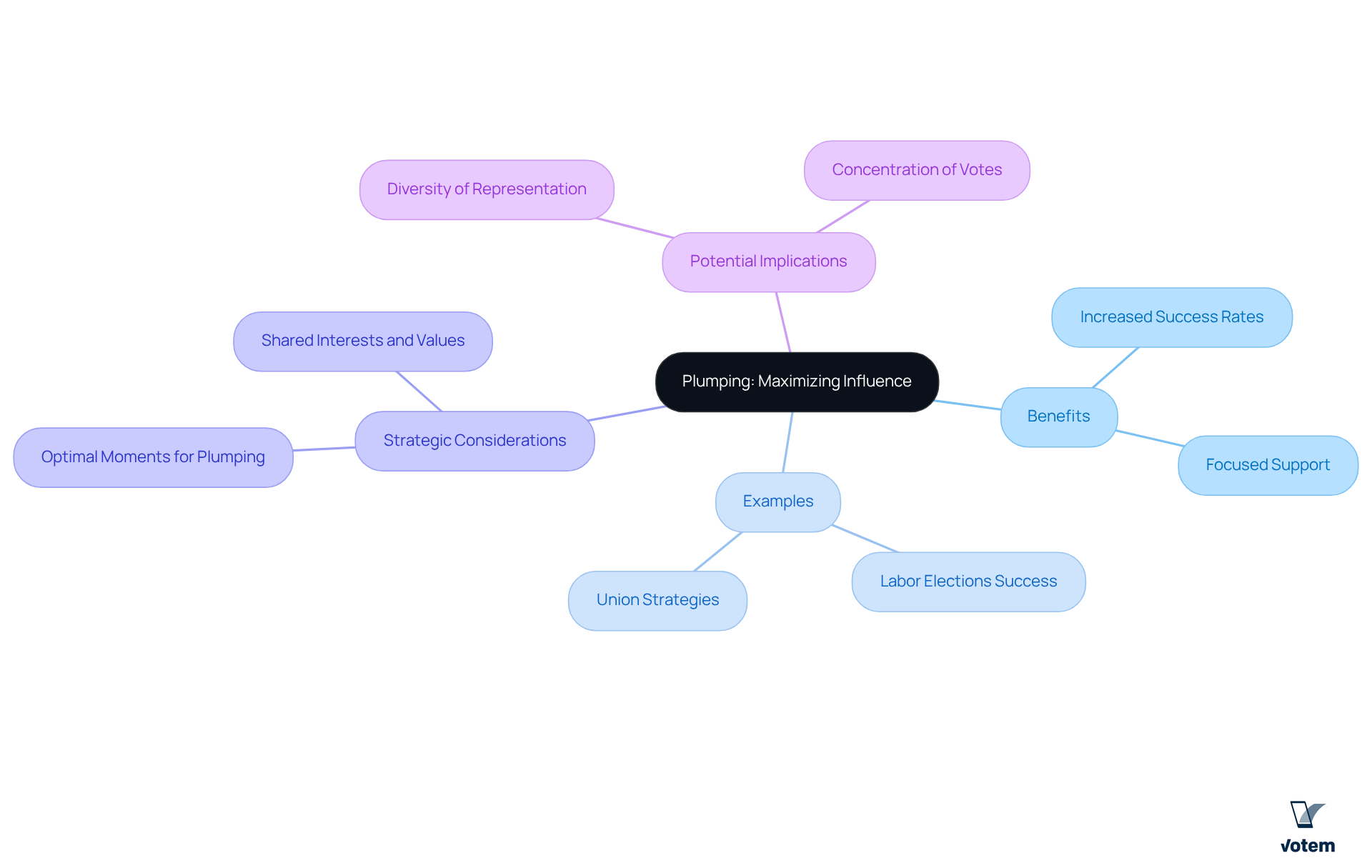
Weighted Voting: Balancing Diverse Interests in Unions
Weighted decision-making assigns varying values to votes based on specific criteria, such as membership tenure or contribution levels. This strategy enables associations to effectively balance the interests of various groups, ensuring that every voice is recognized in the decision-making process. By implementing weighted balloting, associations can alleviate inequalities in influence, promoting a more fair electoral structure. This method not only encourages participation from all members but also cultivates a sense of ownership and accountability in union governance.
For instance, in Ancient Rome, the assemblies employed a weighted decision-making system that favored wealthier citizens, leading to significant disparities in political influence. This historical context illustrates the potential for weighted decision-making systems to either reinforce or challenge existing power dynamics. Furthermore, as economist Branko Milanovic proposes, permitting individuals to convey their strong beliefs through weighted choices can result in a more nuanced representation of member interests.
However, it is essential to recognize that weighted decision-making can also have negative implications, as seen in Southern Rhodesia, where such systems reinforced racial segregation and limited political representation for the majority. Therefore, although the application of weighted voting can improve representation and inclusivity, it is essential for organizations to thoughtfully evaluate its design to guarantee it addresses the collective interests of their varied membership.

Quota Systems: Ensuring Fair Representation in Union Votes
Quota systems serve as essential representation benchmarks for specific groups within organizations, notably women and minority members. By implementing these systems, organizations can ensure that diverse voices are heard, fostering decision-making that genuinely reflects the variety of their membership. This approach not only promotes inclusivity but also bolsters the legitimacy of organizational governance, demonstrating a commitment to fair representation. Consequently, discussions and decisions become more balanced, effectively addressing the needs of all participants. Labor leaders emphasize that such measures are crucial for cultivating an environment where each individual feels valued and included, ultimately enhancing the organization’s overall effectiveness and unity.
For instance, during the 2018 elections, only 13 out of 35 elected women would have secured their positions without the quota system, underscoring its effectiveness in enhancing women’s representation. Historical figures such as Kate Mullany, who organized women workers, and Margaret Haley, a leader for teachers’ rights, exemplify the ongoing struggle for equitable representation in labor. However, it is vital to acknowledge the criticisms surrounding quota systems, as some perceive them as contrary to the principle of equal opportunity. Union leaders should consider these perspectives while advocating for the implementation of quota systems, ensuring they are viewed as a means to achieve true inclusivity rather than a substitute for merit-based selection.

Equal-and-Even Voting: Simplifying Union Decision-Making
Equal-and-even balloting serves as an effective method that ensures each participant has an equal vote, significantly streamlining the decision-making process within organizations. This approach is particularly beneficial in environments where clarity and accessibility are paramount. By implementing equal-and-even voting, organizations can eliminate confusion and ensure that all participants are aware of their voting power. This simplicity not only enhances participation rates but also fosters a sense of unity among participants, as everyone has an equal stake in the outcomes. The impact of this method is profound, as it boosts participant satisfaction and amplifies the collective voice of the organization.
Furthermore, Votem’s innovative online ballot solutions can enhance this process by guaranteeing greater accessibility for all participants, including individuals with disabilities and military voters. Testimonials from satisfied clients highlight Votem’s effectiveness in increasing voter participation, exemplified by the delivery of 123,000 votes—more than double the turnout of the previous election. By embracing these solutions, union leadership can ensure a more inclusive and effective voting process.
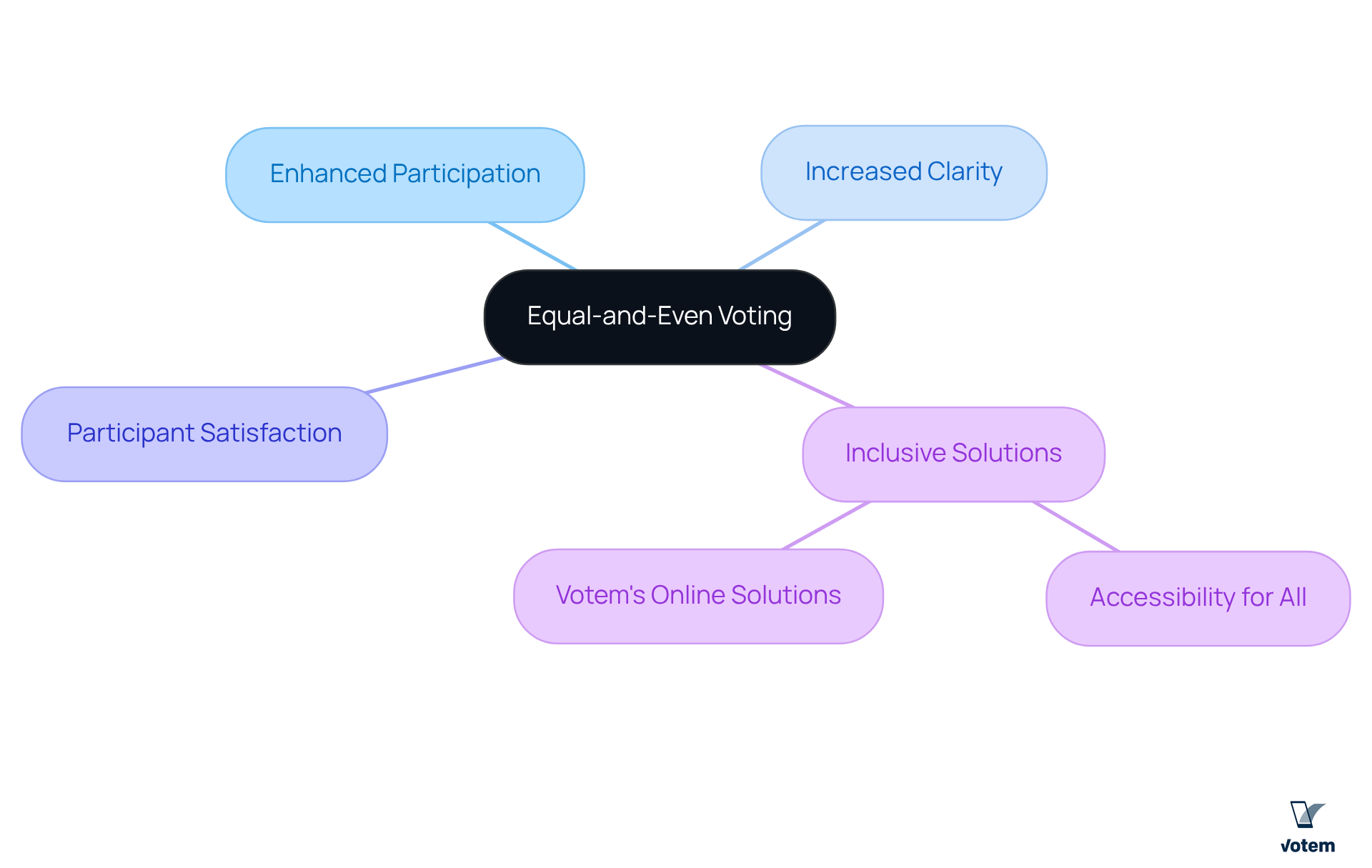
Properties of Cumulative Voting: Enhancing Union Engagement
The cumulative voting example presents essential characteristics that significantly enhance participation among union members. This selection method serves as a cumulative voting example, empowering individuals to express their preferences more comprehensively by allowing multiple votes, which can lead to increased turnout.
Furthermore, by encouraging participants to think strategically about their choices, a cumulative voting example promotes a deeper examination of candidates and issues, ultimately resulting in more informed decision-making. This approach not only empowers individuals but also cultivates a culture of active engagement within organizations.
By fostering such an environment, a cumulative voting example enhances governance and supports a more democratic atmosphere. Union leadership should consider the cumulative voting example as a method to drive meaningful involvement and improve overall organizational effectiveness.
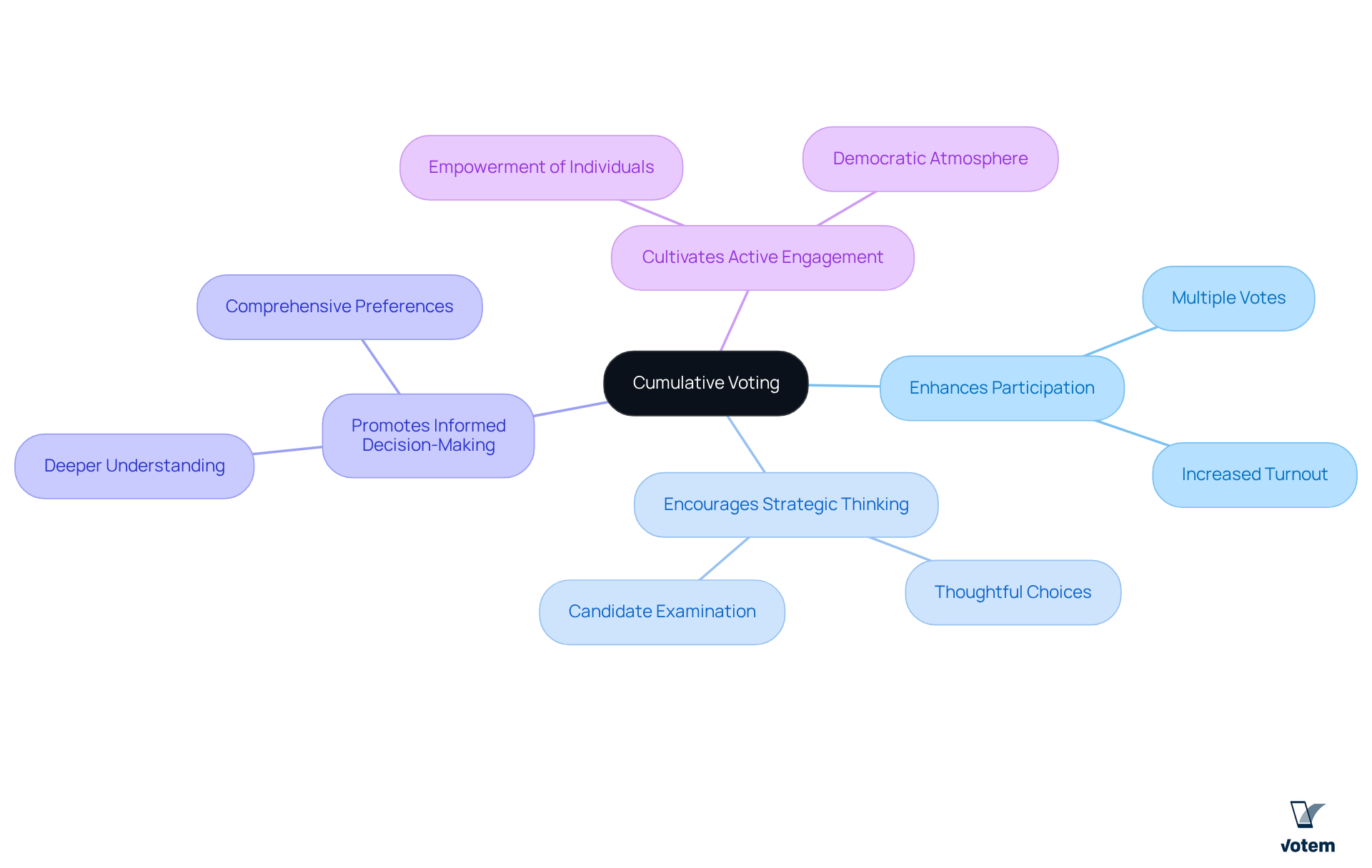
Innovative Applications of Cumulative Voting in Unions
Creative uses of cumulative selection in organizations can manifest in diverse ways, from leveraging technology to streamline the selection process to developing unique engagement strategies that resonate with participants. For instance, unions can harness Votem’s CastIron platform, which offers cutting-edge mobile ballot solutions that enhance accessibility and security. This innovation allows participants to engage seamlessly from any location—whether at home, in the office, or on the go. Such a cumulative voting example not only facilitates cumulative selection but also fosters greater voter trust and involvement.
Furthermore, an educational initiative about the cumulative voting example can empower members to make informed choices. By embracing these advancements, unions can significantly improve their decision-making processes and cultivate a more engaged membership. The proactive adoption of such strategies is essential for union leadership to navigate the complexities of modern electoral processes effectively.
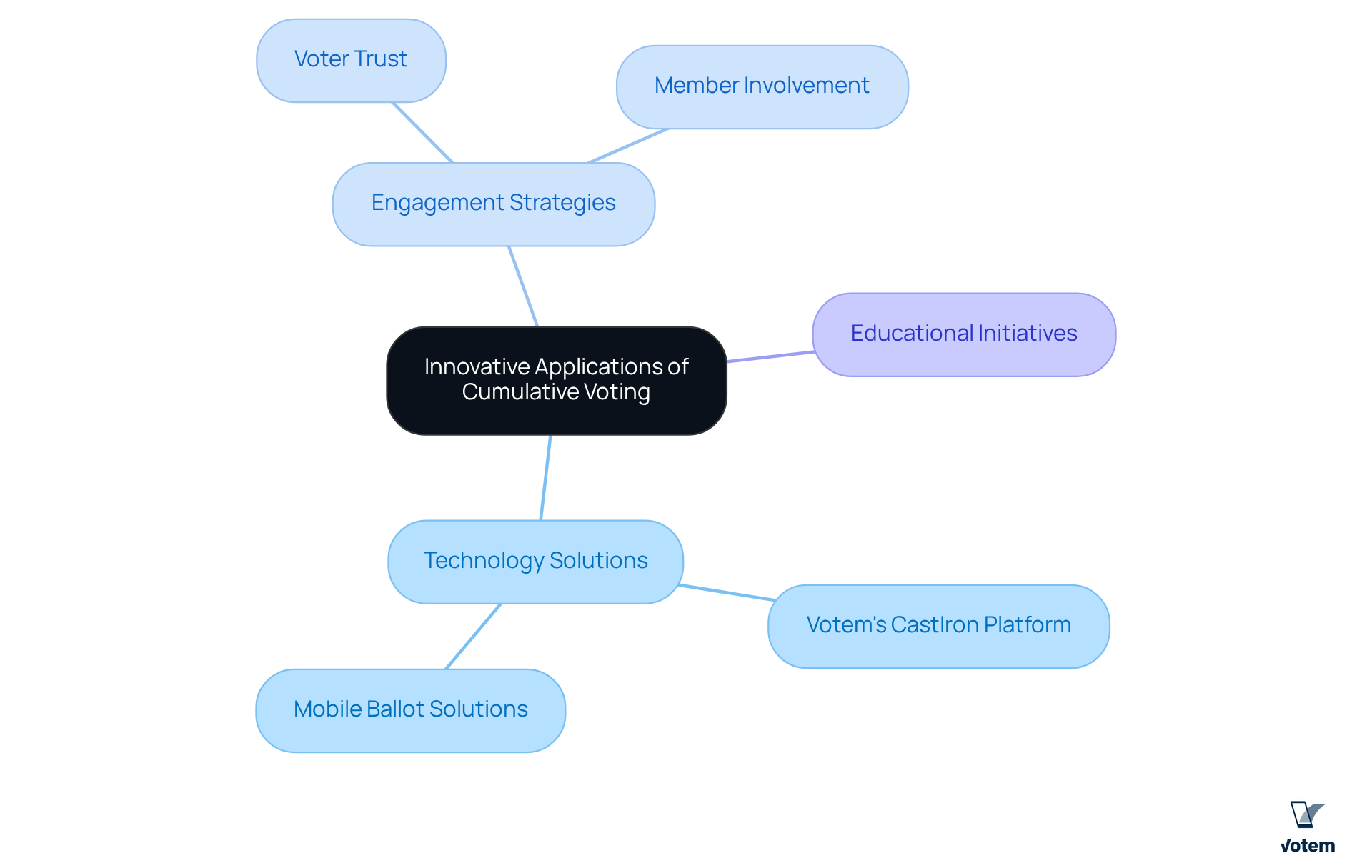
Conclusion
Cumulative voting emerges as a transformative strategy within labor unions, enhancing decision-making by ensuring that every voice is not only heard but also valued. This approach empowers members to allocate multiple votes, fostering a more inclusive environment that reflects the diverse perspectives within the organization. By embracing cumulative voting, unions can effectively counterbalance majority dominance, thereby promoting a democratic atmosphere that encourages active participation.
Furthermore, this article has explored various innovative voting methods, including:
- Dot voting
- Fractional voting
- Plumping
- Weighted voting
- Quota systems
Each technique presents unique advantages that contribute to a more equitable and engaging decision-making process. The historical context of cumulative voting within labor unions underscores its significance, illustrating how this practice has evolved to meet the demands of modern organizations. In addition, the integration of secure online voting solutions, such as Votem’s CastIron platform, exemplifies how technology can enhance participation and ensure transparency in the electoral process.
Ultimately, the adoption of cumulative voting and its associated methods not only strengthens union governance but also cultivates a culture of collaboration and engagement among members. Union leaders are encouraged to implement these strategies to enhance representation and inclusivity, thereby fostering a more robust and effective decision-making framework. By prioritizing diverse voices and innovative practices, unions can navigate the complexities of contemporary labor dynamics and empower their members to shape the future of their organizations.
Frequently Asked Questions
What is the Votem CastIron platform?
Votem’s CastIron platform is a secure online ballot solution designed specifically for labor organizations, ensuring compliance with regulations such as NCUA and DOL requirements.
How does CastIron ensure the security of votes?
CastIron guarantees that every vote is encrypted and auditable, fostering a high level of trust among voters.
What are the benefits of using the CastIron platform for elections?
The platform simplifies the voting process, ensures accessibility for all, increases participant engagement and turnout, and provides features like real-time results and customizable ballots.
How does e-voting impact voter participation?
Research shows that e-voting can significantly boost participation among previously abstaining voters, effectively mobilizing members.
What is cumulative voting in labor unions?
Cumulative voting is a mechanism that allows participants to allocate multiple votes to candidates or issues they support, ensuring that minority perspectives are acknowledged in decision-making processes.
Why is cumulative voting important for labor organizations?
It empowers all members to influence outcomes and fosters a more inclusive environment by allowing diverse viewpoints to shape elections and initiatives.
What should labor leaders consider regarding cumulative voting practices?
Labor leaders should address outdated resources on cumulative balloting and explore case studies that demonstrate its effectiveness in enhancing inclusivity and representation.
What is dot voting, and how is it used in union decisions?
Dot voting is a technique where participants use colored dots to visually express their preferences on various options, streamlining the selection process and facilitating quick aggregation of preferences.
How does dot voting enhance participant engagement?
By promoting open dialogue and allowing members to express their preferences visually, dot voting cultivates a sense of ownership and active participation in the organization’s decision-making processes.
List of Sources
- Votem CastIron: Secure Online Voting for Unions
- Challenges of Trade Union Online Voting – ElectionBuddy (https://electionbuddy.com/blog/2024/03/06/challenges-of-trade-union-online-voting)
- Electing Union Officers Using Remote Electronic Voting Systems (https://dol.gov/agencies/olms/compliance-assistance/tips/remote-electronic-voting-systems)
- Does E-Voting matter for turnout, and to whom? (https://sciencedirect.com/science/article/pii/S0261379420301244)
- Historical Use of Cumulative Voting in Labor Unions
- FairVote – Cumulative Voting (https://archive.fairvote.org/?page=563)
- Dot Voting: Visual Preference Expression in Union Decisions
- Implementing the Condorcet Method for Union Elections | Online Voting with Votem® (https://votem.com/implementing-the-condorcet-method-for-union-elections)
- Conducting Local Union Officer Elections (https://dol.gov/agencies/olms/compliance-assistance/publications/guide-for-conducting-local-union-officer-elections)
- 9 Vote Counter Technologies Transforming Election Accuracy | Online Voting with Votem® (https://votem.com/9-vote-counter-technologies-transforming-election-accuracy)
- Unions – Simply Voting (https://simplyvoting.com/unions)
- Fractional Voting: Tailoring Votes to Member Preferences
- Single Transferable Vote (https://electoral-reform.org.uk/voting-systems/types-of-voting-system/single-transferable-vote)
- Proportional Representation Voting Systems of Australia’s Parliaments | ECANZ (https://ecanz.gov.au/electoral-systems/proportional)
- Method of voting (https://aph.gov.au/About_Parliament/House_of_Representatives/Powers_practice_and_procedure/Practice7/HTML/Chapter3/Method_of_voting)
- Proportional representation – Wikipedia (https://en.wikipedia.org/wiki/Proportional_representation)
- Plumping: Maximizing Influence in Union Elections
- Top Quotes: “No Shortcuts: Organizing for Power in the New Gilded Age” — Jane McAlevey (https://peacejoyaustin.medium.com/top-quotes-no-shortcuts-organizing-for-power-in-the-new-gilded-age-jane-mcalevey-31c4509d4a19)
- United Food and Commercial Workers Union – Page 7 (https://nytimes.com/topic/united-food-and-commercial-workers-union?page=7)
- Tens of thousands protest public spending cuts across France (https://france24.com/en/france/20251002-tens-of-thousands-protest-public-spending-cuts-across-france)
- Hochul’s $3B ‘Inflation Refund’ check plan called cynical ploy by some, lauded by others (https://lohud.com/story/news/ny-news/2024/12/11/hochuls-3b-inflation-refund-check-plan-called-cynical-ploy-by-some-checks-empire-center/76893450007)
- Weighted Voting: Balancing Diverse Interests in Unions
- Weighted voting, revolution and the applause in a concert hall (https://socialeurope.eu/weighted-voting-revolution-and-the-applause-in-a-concert-hall)
- Weighted voting – Wikipedia (https://en.wikipedia.org/wiki/Weighted_voting)
- Quota Systems: Ensuring Fair Representation in Union Votes
- Union reps call for ECB national quota-based employment process (https://euronews.com/business/2024/05/20/irish-economist-urges-staff-quota-system-for-ecb-amid-fears-ireland-may-fall-behind)
- 11 Quotes from Women Labor Leaders (https://blog.dol.gov/2023/03/02/11-quotes-from-women-labor-leaders)
- Political parties in Kurdistan Region seek female, minority candidates (https://voanews.com/a/political-parties-in-kurdistan-region-seek-female-minority-candidates/7807125.html)
- Quotas | International IDEA (https://idea.int/data-tools/data/gender-quotas-database/quotas)
- Equal-and-Even Voting: Simplifying Union Decision-Making
- Labor unions urge Veterans Affairs to restore collective bargaining rights (https://federalnewsnetwork.com/federal-newscast/2025/09/labor-unions-urge-veterans-affairs-to-restore-collective-bargaining-rights)
- Trade union reforms under the Employment Rights Bill: what employers need to know (https://farrer.co.uk/news-and-insights/trade-union-reforms-under-the-employment-rights-bill-what-employers-need-to-know)
- Factors Influencing Voting Decision: A Comprehensive Literature Review (https://mdpi.com/2076-0760/12/9/469)
- Labor Day 2025: What’s Next for Unions? – Non Profit News | Nonprofit Quarterly (https://nonprofitquarterly.org/labor-day-2025-whats-next-for-unions)
- Trade Unions/Industrial Action: Employment Rights Bill Spotlight Series (https://makeuk.org/insights/publications/trade-unionsindustrial-action-employment-rights-bill-spotlight-series)
- Properties of Cumulative Voting: Enhancing Union Engagement
- FairVote – Cumulative Voting (https://archive.fairvote.org/?page=563)

